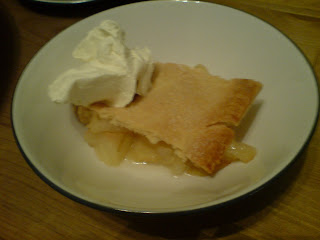I was going to leave the hare that I bought at the Farmers’ Market the other weekend for the 100th recipe, but I thought since a few people were coming over I’d cook it. There are a few recipes in the book, but I went for Stewed Hare with Forcemeat Balls. It’s relatively straightforward. Don’t be scared if you’ve never eaten hare, if you are too squeamish however you can use 6 pigeons or 3 pounds of stewing venison instead. Don’t be scared either of cooking game – all you need is a bit of patience; long, slow cooking is required, but it’s easy enough, get the thing simmering away and you can do whatever you want whilst waiting for it to cook.
FYI: please don’t all go out and order a hare from your butchers – they have had a decline in recent decades. I only bought mine because it just happened to be at the game stall. Check out the
Hare Preservation Trust website for more details.

The trickiest part of this dish is the preparation of the hare itself; unless you have a good butcher who’ll joint it for you, you’ll have to do it yourself. I’m not going to go through how to do it here, but here’s a link to the River Cottage guide to
jointing a rabbit, which is the same principle. I have to say: make sure you invest in sturdy knives, including a meat cleaver, otherwise it’ll be very tricky to do. Also keep any blood and the liver for thickening the stew with later. (Also, don’t tell anyone about that bit, as it may be one step too far for some folk.)

Before jointing

After jointing
Once jointed, turn the pieces of hare in plenty of seasoned flour and brown them well along with one chopped onion and 8 ounces of chopped streaky bacon in 3 ounces of lard (yes, you COULD use oil, but what’s the point in that!?) in a large stockpot or casserole. Add a teaspoon of chopped thyme, a tablespoon of chopped parsley and half a bay leaf to the pot along with enough stock to just cover everything; use either game stock or beef stock, I used half-and-half of each. Charlotte and I added the heart too; seemed silly to waster it since we were using the liver and blood too. Let the whole thing simmer gently until the meat comes away from the bone easily – around 2 or 3 hours. Now add 6 tablespoons of port and a large tablespoon or two of redcurrant jelly along with some salt and pepper and the dish is done! Use a tablespoon of flour slaked with some hot stew liquor to thicken the stew, or use the blood and mashed liver. Don’t let it boil if using blood, as it will curdle not unlike egg yolks in over-cooked custard. Charlotte and I spent a while removing bones from the meat though, so people didn’t have to worry about bones.
Now that’s done, make the forcemeat balls (named forcemeat as you are making a small amount of meat go very far – peasant food, innit?). In a bowl mix together 4 ounces of fresh breadcrumbs, 2 ounces of chopped suet, a tablespoon of chopped parsley, a teaspoon of thyme, the grated rind of half a lemon, 2 ounces of finely chopped bacon, a large egg and some salt and pepper. Form the mixture into balls of around an inch in diameter and fry them until golden in more (yes, more!) lard.
I served it all up with boiled potatoes and peas.
#95
Stewed Hare with Forcemeat Balls – 7/10. The more game I eat, the more I feel I’ve been missing out! I’m always slightly tentative about game, but this is another corker! The stew was rich and thick; hare is very gamy, but the port and redcurrant jelly helped cut through it. Given the chance, I’ll be cooking the remaining hare recipes. The surprise star though was the forcemeat balls – Grigson suggests making them for soups, so if you don’t fancy the hare, make the meatballs! The heart tasted surprisingly nice too...














